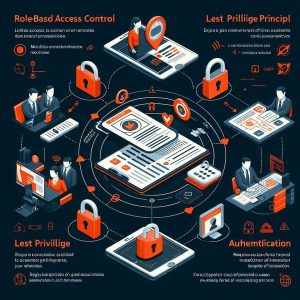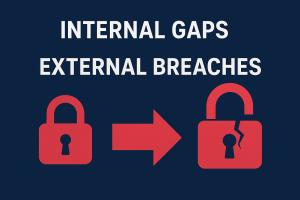The biggest hurdle in the Digital Transformation Implementation Journey is ‘Cybersecurity’, which is a critical concern all over the world. If we check the recent data from Cyber Management Alliance Group, it shows the hackers are targeting the non-IT Industry most, including the manufacturing domain.
As manufacturing companies are adopting new technologies, they face various cybersecurity challenges that must be addressed to ensure the security and integrity of their operations. We can categories of Cybersecurity due to two factors, External and Internal data breach.
External data breaches are one of the most significant cybersecurity challenges facing organizations. These breaches occur when unauthorized individuals or entities access sensitive data stored on an organization’s systems.
|
Phishing Attacks |
Cybercriminals trick employees into revealing login credentials or other sensitive information through deceptive emails or websites. |
| Malware and Ransomware | Malicious software infects systems, allowing attackers to steal or encrypt data and demand ransom. |
| Exploiting Vulnerabilities | Hackers exploit unpatched software vulnerabilities to gain unauthorized access to systems. |
| Third-Party Breaches | Breaches at third-party vendors or partners can compromise an organization’s data if systems are interconnected. |
| Brute Force Attacks |
Attackers use automated tools to guess passwords and gain access to accounts. |
Internal data breaches are a significant cybersecurity concern where sensitive information is compromised from within an organization. These breaches can be intentional or accidental and often involve employees, contractors, vendors or business partners with legitimate access to the organization’s systems.
| Malicious Insider Activity | Employees or contractors intentionally misuse their access to steal, leak, or manipulate data for personal gain or to harm the organization |
| Accidental Data Leaks | Unintentional actions by employees, such as sending sensitive information to the wrong recipient or mishandling data, leading to its exposure |
| Compromised Credentials | Employees’ login credentials are stolen through phishing or other methods, allowing attackers to access systems under the guise of legitimate users. |
| Third-Party Access | Vendors or partners with access to the organization’s systems may inadvertently or intentionally compromise data. |
| Lack of Security Awareness | Insufficient training and awareness can lead to poor security practices, making it easier for data to be accidentally exposed or intentionally stolen. |
Mitigating both internal and external data breaches requires a comprehensive, multi-layered cybersecurity strategy. This is not a one-time activity, but continued involvement and efforts must be made to secure the organization.
Comprehensive Cybersecurity Strategy for Mitigating Internal and External Data Breaches
 1. Access Controls and Authentication
1. Access Controls and Authentication
- Role-Based Access Control (RBAC): Limit access to sensitive data based on employees’ roles and responsibilities.
- Least Privilege Principle: Ensure employees have the minimum level of access necessary to perform their job functions.
- Multi-Factor Authentication (MFA): Require MFA to ensure access requires multiple forms of verification.
- Regular Access Reviews: Conduct periodic reviews of user access rights to ensure they are still appropriate.
- Strong Password Policies: Enforce the use of strong passwords and regular password changes.
Suggested tools
Okta, Microsoft Azure Active Directory, Ping Identity, etc.
2. Monitoring, Logging, and Analytics
- User Activity Monitoring: Use tools to monitor user activities and detect unusual or unauthorized access.
- Audit Logs: Maintain and regularly review audit logs to track access and modifications to sensitive data.
- User Behavior Analytics (UBA): Implement UBA to detect anomalies in user behavior that may indicate insider threats.
- Real-Time Alerts: Set up real-time alerts for suspicious activities, such as large data transfers or access outside of normal working hours.
Suggested tools
Splunk, LogRhythm, Elastic Stack (ELK), Darktrace, Grafana, Prometheus etc
3. Employee Training and Awareness
- Security Training: Conduct regular training sessions to educate employees about data security best practices and recognize potential threats.
- Phishing Simulations: Run phishing simulation exercises to test and improve employees’ ability to identify phishing attempts.
- Awareness Campaigns: Implement ongoing security awareness campaigns to keep employees informed about new threats and best practices.
Suggested Tools
KnowBe4, Cofense, Proofpoint Security Awareness Training, etc
4. Data Encryption and Secure Communication
- Encryption of Sensitive Data: Ensure sensitive data is encrypted both at rest and in transit.
- Secure File Sharing: Use secure file sharing and storage solutions to prevent accidental leaks.
- Robust Encryption Protocols: Use strong encryption protocols and regularly update encryption keys.
Suggested Tools
BitLocker, Signal, ProtonMail etc.

5. Advanced Threat Detection and Response
- Intrusion Detection Systems (IDS): Implement IDS to monitor network traffic for suspicious activity.
- Security Information and Event Management (SIEM): Use SIEM systems to aggregate and analyze security data in real time.
- Endpoint Security Solutions: Implement advanced endpoint protection solutions to secure all devices connected to the network.
- Regular Updates and Patches: Ensure all systems, software, and devices are regularly updated and patched to fix vulnerabilities.
Suggested Tools
Cisco Umbrella, Palo Alto Networks Cortex XDR, EasyNAC, CrowdStrike Falcon, FireEye CheckRed, etc.
6. Incident Response and Disaster Recovery
- Incident Response Plan: Develop and regularly update an incident response plan to quickly address and mitigate breaches.
- Simulation Drills: Conduct regular breach simulation exercises to prepare the response team.
- Regular Backups: Conduct regular backups of critical data and systems.
- Disaster Recovery Plan: Develop and regularly test a disaster recovery plan to ensure quick restoration of operations in case of a breach.
Suggested Tools
Carbon Black, IBM Resilient, Veeam, Commvault etc.
7. Third-Party Risk Management
- Vendor Assessments: Conduct thorough security assessments of third-party vendors and partners.
- Contractual Obligations: Include stringent data protection clauses in contracts with third parties.
- Supply Chain Security: Strengthen supply chain security by ensuring vendors adhere to strict security standards.
Suggested Tools
UpGuard, BitSight, Prevalent etc
8. Regular Security Audits and Assessments
- Penetration Testing: Conduct regular penetration testing to identify and address vulnerabilities.
- Compliance Audits: Ensure compliance with relevant data protection regulations and standards.
Suggested Tools

9. Zero Trust Architecture
- Zero Trust Principles: Implement a Zero Trust security model where trust is never assumed, and verification is required for all access.
- Network Segmentation: Segment networks to limit the spread of breaches and contain threats.
Suggested Tools
Zscaler, EasyNAC, Google BeyondCorp, Illumio etc.
10. Cloud Security
- Cloud Security Policies: Implement robust security policies for data stored and processed in the cloud.
- Encryption and Access Controls: Use encryption and strict access controls for cloud-based data.
Suggested Tools
AWS Security Hub, Microsoft Azure Security Center, Google Cloud Security Command Center, Cloudflare (for WAF), etc.
Read More about the EasyNAC here






